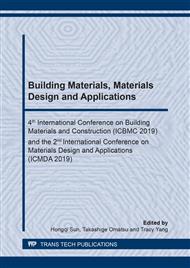[1]
C.J. Zega and A.A. Di Maio, Recycled concrete exposed to high temperatures,, Magazine of Concrete Research, Vol. 58, Issue 10, p.675–682, December (2006).
DOI: 10.1680/macr.2006.58.10.675
Google Scholar
[2]
S. A. Hassan, Effect of Elevated Temperatures on Bond Strength of Steel Reinforcement and Concrete Enhanced with Discrete Carbon Fibers,, Journal of Engineering and Development, Vol. 16, No.4, (2012).
Google Scholar
[3]
L. Biolzi, S. Cattaneo, and G. Rosati, Evaluating residual properties of thermally damaged concrete,, Cement & Concrete Composites, Vol. 30, Issue No 10, p.907–916, (2008).
DOI: 10.1016/j.cemconcomp.2008.09.005
Google Scholar
[4]
H. L. Malhotra, The effect of temperature on the compressive strength of concrete,, Magazine of Concrete Research, 8(22), 85–94, (1956).
DOI: 10.1680/macr.1956.8.23.85
Google Scholar
[5]
U. Schneider, Concrete at high temperatures – a general review,, Fire Safety Journal, Vol. 13(1), p.55–68, (1988).
Google Scholar
[6]
B. Varona, F. J. Baeza, S. Ivorra, D. Bru, Experimental Analysis of the Loss of Bond between Rebars and Concrete exposed to High Temperatures,, Technologia De la Construction, 2011, DOI: http://dx.doi.org/10.6036/7184.
Google Scholar
[7]
L. T. Phan, and N. J. Carino, Review of mechanical properties of HSC at elevated temperature,, Journal of Materials in Civil Engineering, Vol. 10(1), p.58–64, (1998).
DOI: 10.1061/(asce)0899-1561(1998)10:1(58)
Google Scholar
[8]
R. V. Kodur, R. Mcgrath, Fire endurance of high strength columns,, Fire Technology, Vol. 39 (1) pp.73-87, 2003;.
DOI: 10.1023/A:1021731327822
Google Scholar
[9]
G. A. Khoury, Effect of fire on concrete and concrete structures,, Proc. Struct. Eng. Mater J. Vol. 2 (4); pp.429-447, 2001; https://doi.org/10.1002/pse.51.
Google Scholar
[10]
P. D. Morely, R. Royles, Response of the bond in rein forcing concrete to high Temperatures,, Magazine of concrete research, Vol.35 (123) pp.67-74, (1983).
DOI: 10.1680/macr.1983.35.123.67
Google Scholar
[11]
R. H. Haddad, L. G. Shannis, Post fire behaviour of bond between high strength puzzolanic concrete and reinforcing steel,, Construction and. Building. Materials 18 pp.425-435, (2004).
DOI: 10.1016/j.conbuildmat.2004.03.006
Google Scholar
[12]
J. Z. Xiao, H. Falkner, On residual strength of high-performance concrete with and without polypropylene fibres at elevated temperatures,, Fire Safety Journal, Vol. 41(2): p.115–21, (2006).
DOI: 10.1016/j.firesaf.2005.11.004
Google Scholar
[13]
J. Z. Xiao , G. Konig, Study on concrete at high temperature in China-an overview,, Fire Safety Journal, Vol. 39(1): p.89–103, (2004).
Google Scholar
[14]
C. S. Poon, Z. H. Shui, L. Lam, Compressive behavior of fiber reinforced high performance concrete subjected to elevated temperatures,, Cement Concr Res. Vol. 34(12): p.2215–22, (2004).
DOI: 10.1016/j.cemconres.2004.02.011
Google Scholar
[15]
M. J. Terro, Properties of concrete made with recycled crushed glass at elevated temperatures,, Build Environ, Vol. 41(5): p.633–639, (2006).
DOI: 10.1016/j.buildenv.2005.02.018
Google Scholar
[16]
C. S. Poon, S. Azhar, M. Anson, Y. L. Wong, Strength and durability recovery of fire-damaged concrete after post-fire-curing,, Cement Concr Res. Vol. 31(9): p.1307–1318, (2001).
DOI: 10.1016/s0008-8846(01)00582-8
Google Scholar
[17]
R. H. Haddad, R. J. A. Saleh, N. M. A. Akhras, Effect of elevated temperature on bond between steel reinforcement and fiber reinforced concrete,, Fire Safety Journal, Volume 43, Issue 5, Pages 334-343, 2008, https://doi.org/10.1016/j.firesaf.2007.11.002.
DOI: 10.1016/j.firesaf.2007.11.002
Google Scholar
[18]
P.D. Morley and R. Royles, Response of the Bond in Reinforced Concrete to High Temperatures,, Magazine of Concrete Research vol. 35(123), pp.67-74, June (1983).
DOI: 10.1680/macr.1983.35.123.67
Google Scholar
[19]
M. Haskett, D. J. Oehlers, and M. S. M. Ali, Local and global bond characteristics of steel reinforcing bars,, Engineering Structures, vol. 30, pp.376-383, (2008).
DOI: 10.1016/j.engstruct.2007.04.007
Google Scholar
[20]
R. H. Haddad, R. J. Al-Saleh, and N.M. Al-Akhras, Effect of elevated temperature on bond between steel reinforcement and fiber reinforced concrete,, Fire Safety Journal, vol.43, pp.334-343, (2008).
DOI: 10.1016/j.firesaf.2007.11.002
Google Scholar
[21]
S. Cattaneo, and G. Rosati, Bond between Steel and Self-Consolidating Concrete: Experiments and Modeling,, ACI Structural Journal, vol. 106, No. 4, pp.540-550, July-August (2009).
DOI: 10.14359/56620
Google Scholar
[22]
P. D. Morley, R. Royles, Response of the Bond in Reinforced Concrete to High Temperatures,, Magazine of Concrete Research, Vol. 35(123), pp.67-74, (1983).
DOI: 10.1680/macr.1983.35.123.67
Google Scholar
[23]
G. M. Xie and Z. Z. Qian, Research on Bond and Tension Behavior of Concrete after High Temperature,, Journal Zhejiang University Vol.32(5), pp.597-602, (1998).
Google Scholar
[24]
ASTM E119, Standard Test Methods for Fire Tests of Building Construction and Materials,. ASTM, Philadelphia.
Google Scholar


